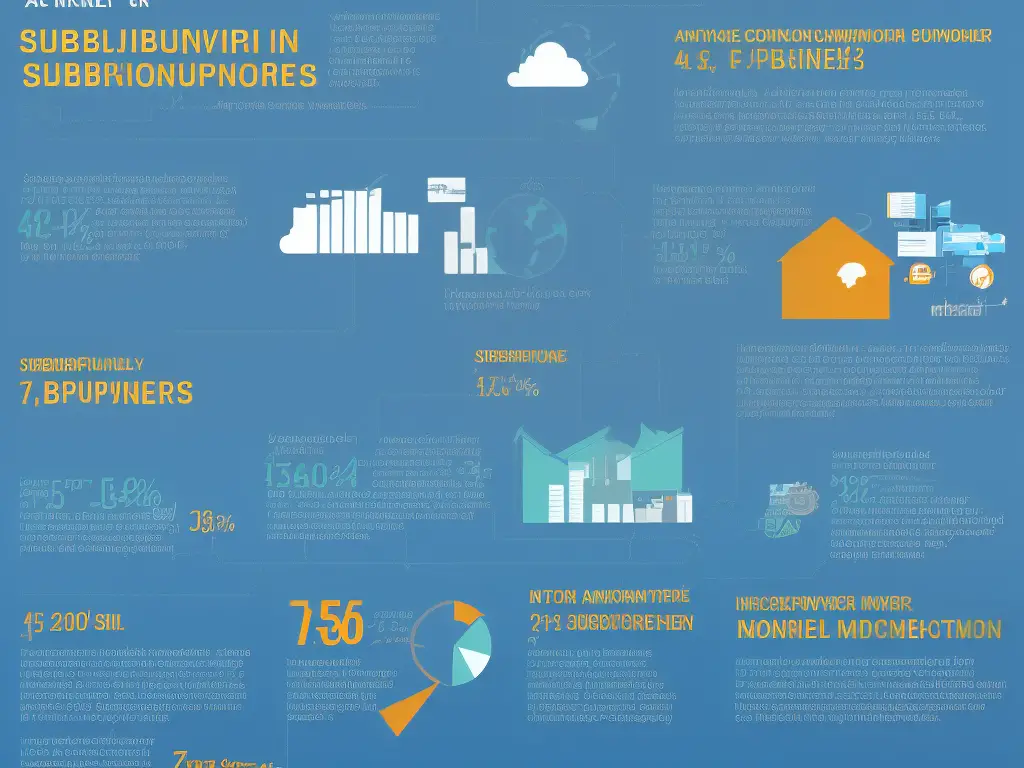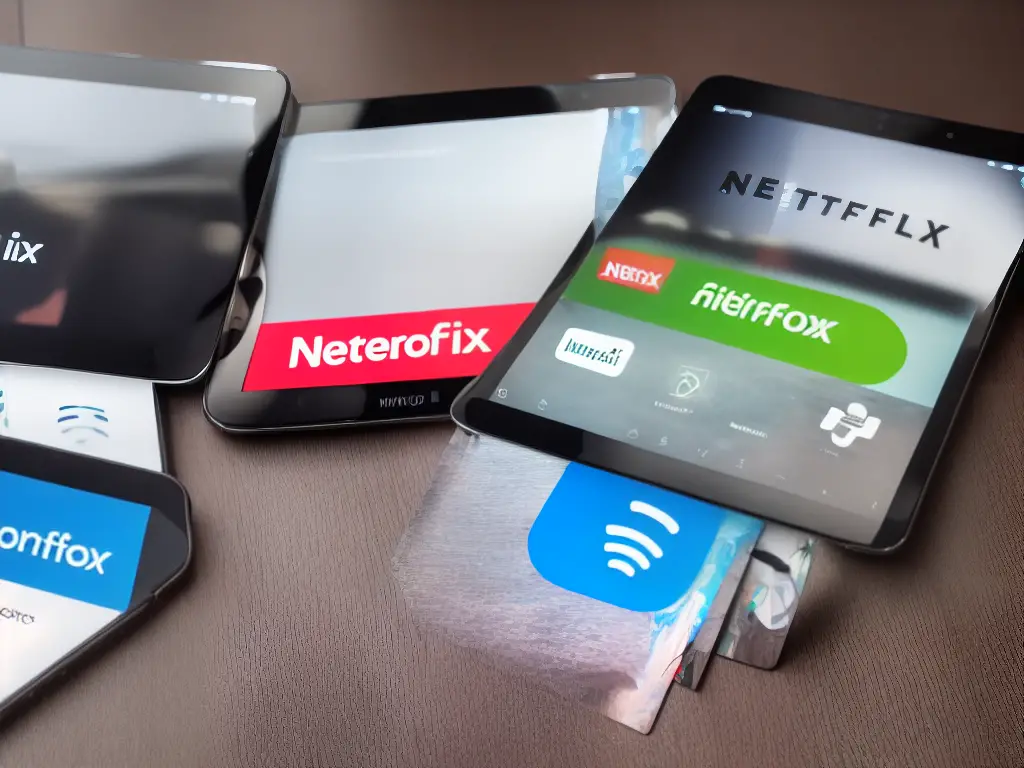In today’s digital era, subscription models have become a prevalent way for consumers to access their desired content on-demand. These models offer a host of benefits, such as convenience, personalization, and value for money. However, they also come with potential drawbacks and challenges. Getting a clear understanding of the different types of subscription models and their implications across various industries can help both consumers and providers make informed decisions.
Introduction to Subscription Models
Subscription models for digital content refer to the method where users pay a recurring fee, usually monthly or annually, in exchange for access to a range of online products or services, such as streaming platforms, news websites, digital software, or online courses. Over the past decade, this business model has become increasingly popular as a way for content providers to generate consistent revenue and build long-term relationships with their customer base. Additionally, subscription models facilitate greater flexibility and convenience, as they allow consumers to access a wide variety of content or services on-demand, without needing to buy or download individual units.
The growing popularity of subscription models can be attributed to several factors. First, the proliferation of high-speed internet and the mass adoption of digital devices, such as smartphones and tablets, have made it easier for users to consume content and services online. Secondly, subscription models can be more cost-effective for both consumers and providers in the long run, as they can leverage economies of scale to offer lower prices and larger selections. Furthermore, subscription models allow providers to collect valuable data on user preferences and consumption habits, enabling them to create more targeted and personalized offerings, which can drive customer satisfaction and loyalty.
However, there are also potential drawbacks associated with these models. For consumers, an over-reliance on subscription services may lead to a higher monthly expenditure, especially if they subscribe to multiple platforms that provide overlapping content or services. Additionally, it can create a dependence on digital content providers, as users may struggle to discontinue their subscriptions due to sunk costs or fear of missing out. This can also result in the potential for a diminished sense of ownership and control, as content is typically accessed on the provider’s platform rather than being downloaded and stored on a user’s personal device.
On the provider side, subscription models may require continuous investment in content development or licensing, customer acquisition, and platform maintenance to remain competitive in an increasingly crowded market. Additionally, success often depends on achieving a critical mass of subscribers to offset the initial costs of setting up and running the service, as well as to generate sustained revenue growth. This dynamic can sometimes lead to price wars or the consolidation of smaller players, which may negatively impact the overall diversity and quality of available content or services.
One interesting trend that has emerged from the proliferation of subscription models is the rise of bundled offerings, where multiple digital content or services are combined within a single subscription package. This approach allows providers to differentiate themselves through the unique value proposition of their bundles, while also encouraging subscribers to consolidate their spending with a single provider. As the subscription economy continues to evolve, we can expect further innovation in business models and pricing strategies aimed at maximizing user engagement and provider profitability, while minimizing potential drawbacks for both parties.

Major Types of Subscription Models
As digital content providers continue to explore various methods for monetizing their platforms and offerings, subscription models have proven to be one of the most effective ways to generate recurring revenue. This is primarily manifested as an access model, which employs either a paywall or a freemium approach. Paywalls require users to subscribe to a service in order to access some or all of the content, while freemium models offer a mix of free and premium content, enticing users to upgrade to a paid subscription. Examples of successful paywall implementations can be found in major digital publications, such as The New York Times and The Wall Street Journal. As the trend of bundled offerings gains traction, it is likely that an increasing number of digital content providers will adopt this strategy to create a more compelling and convenient experience for their users.
Bundling models are another popular subscription type used by digital content providers to increase customer engagement and retention. With this approach, multiple products, services, or content items are grouped into a single subscription. Bundling may involve aggregating content from various sources or combining complementary services to provide a more comprehensive experience. Examples of bundling in the digital content space include video streaming platforms, like Netflix and Hulu, and music streaming services, such as Spotify and Apple Music.
Usage-based models are designed to charge customers based on their consumption of digital content or utilization of a service. This approach ensures that the pricing structure aligns with individual user preferences, offering consumers the flexibility to pay for only what they consume. Metered paywalls, for instance, offer a limited amount of free content before users are prompted to subscribe, giving them the option to access the service in accordance with their usage levels.
Hybrid subscription models combine elements of the aforementioned models to create unique strategies tailored to individual businesses and their customers. For example, some digital content providers might employ a freemium model with usage-based pricing for additional features or premium content. Another possible hybrid strategy involves employing a base subscription fee alongside usage-based billing for additional services or content. This flexible approach can help businesses better cater to the diverse needs and preferences of their audience.
The digital content industry, comprising of services like music and video streaming platforms, has adopted various subscription models to effectively generate revenue and maintain customer satisfaction. These models, which include access, bundling, usage-based, and hybrid subscriptions, are tailored to provide unique benefits and challenges to content providers. By considering these different approaches, businesses can maximize their revenue potential while attracting and retaining users.

Comparing Subscription Models Across Industries
For instance, music streaming services like Spotify, Apple Music, and Amazon Music have become the dominant method to access digital content, mainly through subscription models. These services offer ad-supported free options along with premium access for a monthly subscription fee. Premium subscriptions generally provide ad-free listening, higher audio quality, and offline playback options. Similarly, the video streaming industry, comprising platforms like Netflix, Hulu, and Disney+, operates on a subscription-based model granting users access to vast libraries of television shows and movies in exchange for a monthly fee.
News publishing has also embraced subscription models in recent years, with digital paywalls in place for various publications including The New York Times, The Wall Street Journal, and The Washington Post. These outlets typically provide limited access to their content for free, requiring users to pay a monthly or annual subscription fee to access premium content or simply to unlock a greater number of articles per month.
In some cases, flexible options are available, such as tiered subscription plans with different levels of content access, or unique subscription bundles that aggregate multiple publications under one subscription.
The online gaming industry has seen subscription models evolve over time. Originally, subscription-based models were prevalent in massively multiplayer online games (MMOs), which required continuous server upkeep and content updates. Developers and publishers like Blizzard Entertainment, with the popular title World of Warcraft, supported their continuous development through monthly subscription fees. More recently, even videogame platforms have implemented subscription services. For example, Microsoft’s Xbox Game Pass and Sony’s PlayStation Now give gamers access to a curated list of titles for a recurring monthly fee, adding an additional option to the traditional one-time purchase of individual games.
The Software as a Service (SaaS) model has played a significant role in transforming the accessibility and purchasing experience of digital tools for users within the software industry. Instead of buying a software license upfront, users can now access software by subscribing to a SaaS model and paying a subscription fee as long as they wish to use it. This approach has become popular across various industries, with notable examples including Microsoft Office 365 and Adobe Creative Cloud for productivity tools, as well as customer relationship management (CRM) platforms like Salesforce.
By adopting a subscription model, software companies benefit from predictable, recurring revenue streams while ensuring that users continually receive the most up-to-date features and improvements.

Key Factors in Subscription Model Pricing & Implementation
When considering subscription models for digital content, one essential factor to take into account is the cost of providing the content itself. This encompasses all expenses associated with sourcing, producing, and distributing content, such as compensating content creators, obtaining copyright permissions, and maintaining dedicated hosting servers. Ideally, the pricing of a subscription should cover these costs while also generating an acceptable profit margin. Subscription prices tend to be higher when the content provided is of exceptional quality, unique, and attractive to the target audience, justifying the associated costs.
Perceived value is another significant factor that influences subscription pricing. The perception of value varies among customers, and the pricing should appeal to a broad range of potential subscribers. The content must offer value in terms of quality, uniqueness, or relevance to the target audience, providing a convincing reason to pay for a subscription. Strategies such as offering a free trial to showcase the content’s value or providing additional perks, like ad-free browsing, can help establish the content’s worth in the eyes of potential subscribers.
Competition plays a role in pricing decisions when determining subscription prices for digital content. Understanding the competitive landscape helps to identify gaps and opportunities for differentiating the content offering. A competitive analysis allows businesses to understand how similar content providers price their subscriptions and whether they offer additional benefits, such as bundle deals or exclusive access to premium content. By carefully considering their competition, digital content providers can position their content at a price point that attracts customers without compromising profitability.
Price sensitivity refers to the degree to which customers’ subscriptions are affected by price changes. It is essential to consider customers’ price sensitivity while determining subscription pricing tiers. For instance, if a price increase causes a significant number of subscribers to cancel, the demand is price-sensitive. To account for this sensitivity, digital content providers can consider offering multiple pricing plans catering to various customer preferences and budgets. This approach enables them to capture value from customers willing to pay a premium while still appealing to price-sensitive customers.
Free trials and discounts play a crucial role in transforming potential customers into paying subscribers by providing them with a risk-free opportunity to experience the content and value proposition. However, digital content providers must carefully balance the duration and exclusivity of these promotions for optimal results. Overly generous free trials or discounts may devalue the content and make customers reluctant to pay for a full-price subscription, while short or inadequate promotions may not give users enough time to appreciate the content’s worth. To address these competing concerns and maximize engagement and revenue, providers can offer a range of discounted pricing tiers catering to the diverse needs of their customers.

Customer Acquisition & Retention Strategies
Beyond promotional strategies, effective customer acquisition and retention are essential for the success of subscription-based digital content services. To attract and maintain a loyal subscriber base, businesses must target specific audience segments and tailor their content offerings to satisfy their preferences. By collecting and analyzing data on customer demographics and behavior, companies can identify patterns among potential and existing subscribers, allowing them to customize content and promotions to better resonate with their target audience. This targeted approach can bolster overall customer satisfaction, improving the likelihood of sustained subscriptions.
An effective way to attract and retain subscribers is by providing exclusive offers and benefits. Special promotions, such as time-limited discounts or free trial periods, incentivize users to try the service and increase the likelihood of converting them into long-term subscribers. Additionally, offering exclusive content or features that are unavailable elsewhere can create a sense of exclusivity and loyalty among subscribers, encouraging them to remain engaged with the platform. For example, streaming platforms may offer original programming or early access to new releases to distinguish themselves from competitors and keep subscribers coming back for more.
Leveraging content recommendation algorithms is another essential strategy for engaging and retaining subscribers. By analyzing user behavior and preferences, these algorithms enable businesses to serve personalized content that is more likely to resonate with individual subscribers. A well-curated, personalized content selection keeps users engaged, driving consumption and subscription renewal. Moreover, presenting tailored content recommendations can also facilitate audience discovery of new content categories, increasing the value of the subscription to the users.
Another aspect to consider for customer acquisition and retention is to create a frictionless user experience. Ensuring that the signup or subscription process is easy, quick, and user-friendly can minimize the barrier to entry for potential subscribers. Furthermore, optimizing customer support through channels such as chat support, email, or social media can help address user concerns and prevent churn due to unresolved issues.
Last but not least, fostering a sense of community among subscribers can improve customer retention. Establishing forums or social media groups to discuss, review, or share content can provide added value for users and create a sense of belonging. Additionally, hosting special virtual events, such as live Q&A sessions with content creators, can deepen the connection between subscribers and the platform or service. These community-building efforts contribute to a positive user experience and can boost overall satisfaction and engagement, ultimately leading to stronger customer retention.

Measuring Subscription Model Success
In order to assess the effectiveness of these community-building initiatives on subscription models for digital content, it is essential to understand the key performance indicators (KPIs) that commonly evaluate their success. One such KPI is subscriber growth, which tracks the increase in the number of subscribers over a specified period. This metric is useful for gauging how well a company’s marketing and customer acquisition strategies are performing, as well as how appealing the digital content and community efforts are to the target audience.
Another critical KPI is the churn rate, which indicates the proportion of subscribers who discontinue their subscriptions within a given period. A high churn rate could signal issues with the quality or relevance of the digital content, dissatisfaction with the user experience, or ineffective pricing strategies. Therefore, monitoring this metric can help businesses identify areas requiring improvement and take necessary actions to retain customers and maintain a healthy subscriber base.
Average revenue per user (ARPU) is another important KPI for measuring the success of a subscription model, as it reveals how much revenue, on average, is generated from each subscriber. This metric can be useful for evaluating the effectiveness of pricing strategies and identifying opportunities for upselling or cross-selling additional products and services to existing customers. By optimizing ARPU, companies can enhance their profitability and ensure the long-term sustainability of their subscription models.
Customer lifetime value (CLV) represents the total revenue a company can expect to generate from a customer throughout their entire relationship. CLV not only takes into account factors such as subscriber growth, churn rate, and ARPU but also considers customer support and marketing costs related to retaining subscribers. This metric is essential for understanding the true value of customers, gauging customer loyalty, and making informed decisions on investments in customer acquisition and retention.
To become informed about subscription models for digital content, it’s essential to understand the key performance indicators (KPIs) that measure their effectiveness, such as subscriber growth, churn rate, average revenue per user, and customer lifetime value. By monitoring these metrics, businesses can identify trends, address challenges, and make data-driven decisions to improve their subscription offerings, ultimately leading to greater customer satisfaction, retention, and increased revenue generation.

Case Studies & Examples of Successful Subscription Models
An excellent example of a successful subscription model is Netflix, an American streaming platform that offers a wide variety of TV shows, movies, and documentaries to millions of subscribers worldwide. Netflix’s success is primarily attributed to its innovative content strategy, which involves producing original content and acquiring licenses for existing shows and movies. This approach consistently provides a diverse and fresh library of content that appeals to an international audience, resulting in their rapid growth, boasting over 208 million subscribers in 2021. This demonstrates how the right strategies and monitoring of KPIs can positively impact digital content subscription models.
Another notable example of a successful subscription-based platform is Spotify, a music streaming service that provides access to millions of songs. Launched in 2008, Spotify revolutionized the music industry by offering legal access to music at an affordable rate, instead of resorting to piracy. The company has made constant improvements to its service by incorporating features such as curated playlists, podcasts, and social integration, helping it attract a substantial user base. By the end of 2020, Spotify boasted 155 million paying subscribers, making it the largest music streaming company in the world.
The New York Times, an esteemed news organization, has made remarkable strides in adapting its subscription model for the digital age. The company successfully transitioned from a print-focused medium to one that capitalizes on digital subscriptions. By utilizing a metered paywall, The New York Times appealed to a broad audience, combining a limited number of free articles with subscription options to unlock unlimited access. Through a strong emphasis on high-quality journalism and investing in digital innovations, The New York Times has achieved considerable growth and reported over 7.5 million total subscriptions by the end of 2020.
Careful examination of the strategies employed by these successful models reveals several key lessons for subscription-based businesses. Firstly, providing value to subscribers through a diverse and regularly updated content offering is fundamental. By doing this, companies are able to retain and attract subscribers, as evidenced by Netflix and Spotify. Secondly, investing in technology and digital innovations that not only enhance user experience but also build credibility and trust, as demonstrated by The New York Times’ transition to a digital news platform.
As the digital content market continues to evolve, subscription models must be both flexible and scalable to cater to different market segments. Companies should consider offering a variety of pricing plans and options to suit individual preferences while studying local preferences and adapting their offerings accordingly. For example, Netflix has successfully catered to international audiences by producing content in local languages and targeting specific cultural themes. By understanding and implementing these key strategies, businesses can design and maintain successful subscription models that stand the test of time.

Future Trends & Challenges in Subscription Models
Building upon this idea of adaptability, one emerging trend in subscription models for digital content is the rise of bundled subscriptions. These bundles combine multiple services or platforms into a single package at a discounted rate. This strategy not only provides value to the users, but it also helps companies retain customers by offering a wider range of services. For instance, companies like Apple and Amazon offer bundled subscription plans that include music streaming, video streaming, and cloud storage services. As the market becomes increasingly saturated and competitive, bundling various services together is expected to grow in popularity as providers seek new ways to differentiate themselves and entice customers.
Another future trend in subscription models for digital content is the personalization of content and pricing. With access to vast amounts of user data, digital content providers can leverage artificial intelligence and machine learning algorithms to tailor content and offerings to individual preferences. This may result in dynamic pricing models, where users pay for specific pieces of content that they are interested in, rather than a flat rate for a broad range of content. Personalization may also be applied to the type of content that is generated and recommended to users, which would further drive engagement and retention.
Subscriber fatigue is a significant challenge that digital content providers must address, as more companies enter the space and attempt to attract users with an array of subscription options. Consumers are increasingly faced with a bewildering array of choices for subscription-based digital content, and it can be difficult to justify paying for multiple services with overlapping content offerings. To alleviate subscriber fatigue, content providers may need to focus on creating exclusive, high-quality content that captures users’ attention in a crowded marketplace. Additionally, providers may consider partnerships and collaborations with other providers to offer a more diverse range of content without overwhelming users.
As ad-supported content continues to grow in popularity, it presents another challenge for subscription-based content providers. Many users prefer ad-supported content because it allows them to access content for free or at a lower cost compared to subscription models. For example, platforms like YouTube and Spotify offer both ad-supported and premium subscription-based options to cater to different user preferences. Subscription-based content providers must find ways to offer unique value that sets them apart from ad-supported alternatives, such as exclusive content, better user experience, or additional features and benefits.
Lastly, the rise of decentralized and user-generated content could disrupt traditional subscription models in the future. Blockchain technology and decentralized platforms have opened up new possibilities for content creators to monetize their work directly through peer-to-peer transactions, cutting out intermediaries and thus potentially challenging subscription-based models. Meanwhile, social media platforms have turned users into content creators themselves, driving a large amount of free, user-generated content that may compete with paid subscription models. Content providers will need to innovate and adapt to these emerging trends if they want to remain relevant and competitive in the dynamic digital content landscape.

By diving into the world of subscription models and exploring their nuances, we can gain valuable insight into the strategies employed by successful companies like Netflix, Spotify, and The New York Times. By understanding the key factors that influence subscription pricing and implementation, as well as emerging trends and challenges, we can better anticipate future developments in this rapidly evolving landscape. Whether you are a content consumer or a provider, staying informed about subscription models is essential in order to adapt and succeed in this digital age.

